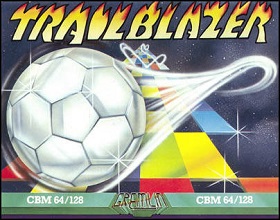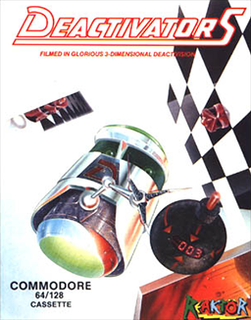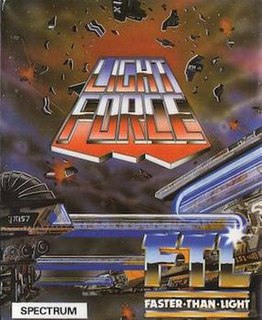
Alien 8 is an action-adventure video game developed and published by Ultimate Play the Game. It was released for the ZX Spectrum, BBC Micro, Amstrad CPC and MSX in 1985. The game is a spiritual successor to the best-selling Knight Lore, which was lauded by critics for its isometric graphics. In the game, the player takes control of a robot, Alien 8, whose job is to ensure that all of the cryogenically frozen passengers on board a starship remain viable during the ship's voyage.

Knight Lore is a 1984 action-adventure game developed and published by Ultimate Play the Game, and written by company founders Chris and Tim Stamper. The game is known for its use of isometric graphics, which it further popularized in video games. In Knight Lore, the player character Sabreman has forty days to collect objects throughout a castle and brew a cure to his werewolf curse. Each castle room is depicted in monochrome on its own screen and consists of blocks to climb, obstacles to avoid, and puzzles to solve.

Monty on the Run is a computer game created by the software house Gremlin Graphics and released in 1985 for the Commodore 64, ZX Spectrum, Amstrad CPC and Commodore 16, written by Peter Harrap for the ZX Spectrum with the iconic in-game music on the Commodore 64 provided by Rob Hubbard. It is the third game in the Monty Mole series.

Trailblazer is a video game that requires the player to direct a ball along a series of suspended passages. It was originally released by Gremlin Graphics for the ZX Spectrum, Commodore 64, Atari 8-bit family, Amstrad CPC, and C16/plus/4 in 1986. It was ported to the Amiga and Atari ST.

Tornado Low Level is a multidirectional flight game developed by Costa Panayi and published in 1984 by the company he co-founded, Vortex Software. The game was released for the ZX Spectrum in 1984, with ports for the Amstrad CPC and Commodore 64 in 1985.

Cauldron is a shoot 'em up platform game developed and published by British developer Palace Software. The game was released in 1985 for the ZX Spectrum, Commodore 64 and Amstrad CPC home computers. Players control a witch, who aims to become the "Witch Queen" by defeating an enemy called the "Pumpking".

Amtix is a magazine that originally reviewed Amstrad computer software in the mid-1980s, published monthly by Newsfield Publications Ltd.

Tony Warriner is a video game designer, programmer and co-founder of Revolution Software. At a young age he started playing adventure games, when they were just text adventures. He wrote his first game, Obsidian, while he was at school and sent it to Artic Computing for consideration. Artic's director, Charles Cecil, loved the game and convinced him to license it to Artic, and then to join Artic as a programmer. At Artic he wrote, together with Adam Waring, Ultima Ratio which was published in 1987 by Firebird. In the same year he got a job at Cecil's Paragon Programming, where games from US publishers were converted to European platforms. When Cecil had left to work for U.S. Gold, Warriner started doing 8-bit programming for games. In 1988 he created Death Stalker, published by Codemasters. In the same year he joined Cascade Games, where he worked on 19 Part One: Boot Camp, Arcade Trivia Quiz, and Arcade Trivia Quiz Question Creator. In 1989 Warriner moved to Bytron Aviation Systems based in Kirmington, Lincolnshire, where he wrote software for the aviation industry, David Sykes was his fellow programmer.

Mission Omega is a computer game published in 1986 by Incentive Software for the ZX Spectrum, Commodore 64 and Amstrad CPC home computers. It was programmed by Stephen Ward.

Deactivators is a 1986 puzzle video game designed by David Bishop and Chris Palmer, developed by Tigress Marketing and System Software, and published by Ariolasoft's action game imprint Reaktor. The player controls bomb disposal robots known as deactivators and must use them to deactivate bombs planted by terrorists in five research complexes. The concept for the game came from a brainstorming session between Bishop and Palmer; its design and development took five to six months to complete. It was released for the Amstrad CPC 464, Commodore 64, and ZX Spectrum platforms in October 1986.

Peter Pack Rat is a 1985 platform game developed and released by Atari Games for the Atari System 1 arcade hardware. It was programmed by Peter Thompson, with graphics by Debbie Hayes and music by Brad Fuller. The game was only produced in small quantities, either as a standalone cabinet or as an upgrade kit to existing ones.

Three Weeks in Paradise is a computer game released in 1986 by Mikro-Gen for the ZX Spectrum and Amstrad CPC platforms. It is the last action-adventure platform game from the Wally Week series.

Dragontorc is an action-adventure game developed by Steve Turner's Graftgold and released for the Amstrad CPC and ZX Spectrum by Hewson Consultants in 1985. It is a sequel to 1984's Avalon The 3D Adventure Movie. The hero of Avalon, Maroc the Mage, returns to defeat an evil witch and save Britain. The game was very well received by critics.

Light Force is a 1986 vertically scrolling shooter designed by Greg Follis and Roy Carter, developed by their company Gargoyle Games, and published under their Faster Than Light imprint. It was released for the Amstrad CPC, Commodore 64, and ZX Spectrum platforms.

Zoids: The Battle Begins is a 1986 video game designed by Chris Fayers, developed by the Electric Pencil Company, and published by Martech. and released in Europe for the ZX Spectrum, Amstrad CPC, MSX and Commodore 64 computers. Based on the Zoids toy series, the player controls a human who was fused with one of the robots and has to reclaim parts of a larger mech.

Seymour Goes to Hollywood, also known as Seymour at the Movies, is a platform and adventure game developed by Big Red Software and originally published in Europe by Codemasters in 1991. Players control Seymour, a small potato-like creature who wishes to be a film star. The film's script has been locked in a safe, meaning Seymour must solve puzzles by collecting and using objects scattered throughout the game in order to progress, ultimately retrieving the script and allowing filming to start.

Jet-Boot Jack is a platform game written by Jon Williams for the Atari 8-bit family and published by English Software in 1983. It was ported to the Acorn Electron, Amstrad CPC, BBC Micro, and Commodore 64. A C64-only sequel, Legend of the Knucker-Hole, was released in 1984.

Soft & Cuddly is a horror arcade adventure game released for the ZX Spectrum home computer, developed by John George Jones and published by The Power House. It was released in September 1987 in the United Kingdom and in early 1988 in Spain. The player assumes the role of a man armed with a laser gun and a jet pack, whose mother, the Android Queen, has been dismembered. The player's task is to locate the scattered body parts of the Android Queen and sew her back together.

The Battle for Midway is a turn-based strategy video game developed and published by Personal Software Services. It was first released in the United Kingdom and France for the MSX in 1984, and was re-released for the Amstrad CPC, Commodore 64 and ZX Spectrum in 1985. It is the second instalment of the Strategic Wargames series. The game is set during the Battle of Midway in the Pacific Ocean theatre of World War II and revolves around the United States Navy attacking a large Imperial Japanese fleet stationed at Midway Atoll, in retaliation for the attack on Pearl Harbor.

Ace is a combat flight simulator video game published for the Commodore 64, VIC-20, and Plus/4 in 1985 by Cascade Games. It was ported to the Amstrad CPC, Amstrad PCW, Amiga, and ZX Spectrum.




















